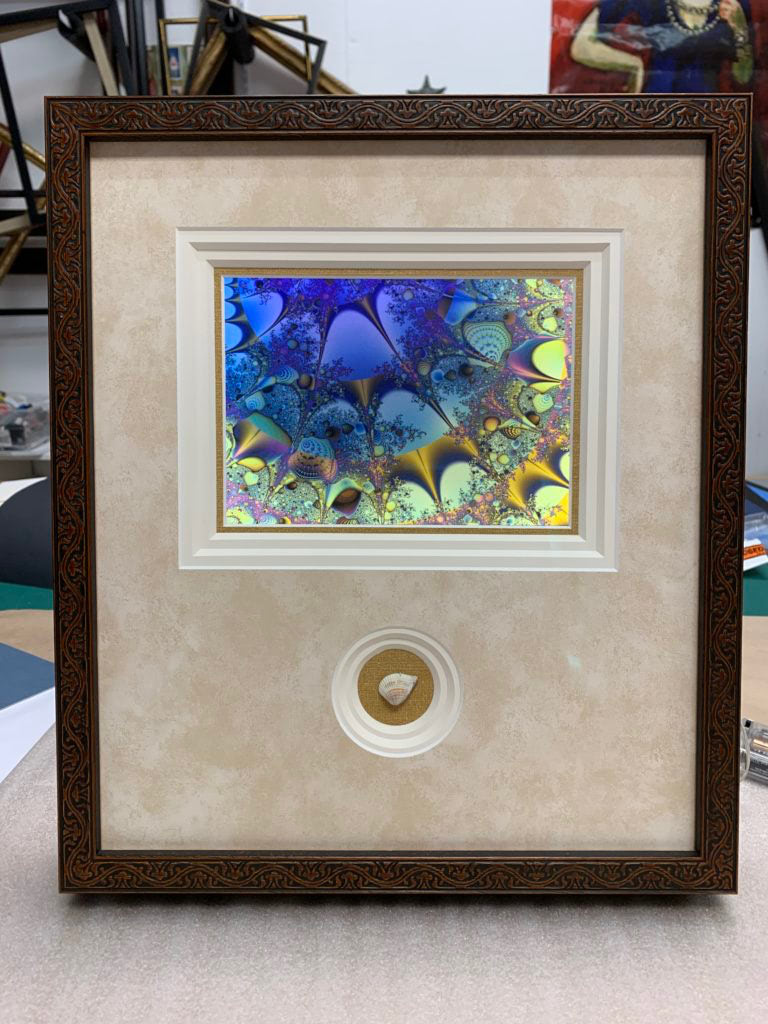Mark Kubo – a partner and framer at FireLight Gallery & Framing in Petersburg, Alaska – was awarded the Judge’s Choice award for high points by first time entrant in the Print Competition category, in the International Framing Competition organized by the Professional Picture Framers Association (PPFA).

That’s a long way of saying that Mark’s framing project of a computer-generated fractal art that 14 others also framed – was the best of the first-time entrants in the competition. And the short of it is that he took the honor home by utilizing two Tru Vue® Conservation Grade products, Optium Museum Acrylic® and Conservation Clear® Acrylic, to deliver a creative and unique design.
The Print & The Motif
The fractal art print selected for the International Framing Competition is semi-transparent, so colors and textures underneath “ghost” through the image. When Mark first looked at the print, he saw “shells” repeated throughout, and that sparked an idea. “The curves in the piece reminded me of ocean waves,” he says. “That created the theme that I wanted to evoke: an ocean and beach motif.”

The Design
“The art itself was created using a very modern medium and technique, but the subject matter, fractals are found organically in nature, “Mark says. “So with the design I wanted to tie together a high-tech technique with the organic. This inspired me to add an actual shell that is placed in the circle opening, and add LED lights within the interior of the frame that lights up the transparent print from the back so that it glows.”
Mark attached the shell to the piece by using two-piano wires, counterbalanced with opposing forces to keep it secure. On the backside, the wires are held down with hinging tape by ASAP Tapes.

The Interior
While it’s not noticeable at first glance, Mark’s competition piece actually is a two-layered design. The interior layer is not meant to be visible, but it allowed him to add the high-tech element- a strip of LED lights to backlight the vellum print and soften the light.
When Mark first tested the LED lights, he was not happy with the results. The lights reflecting off the white foam board made the print too blue, losing its original warmth. To rectify this, he had an ingenious solution- to use a combination of colored matboards placed on the back about 1” behind the lights to warm up the overall color temperature while resulting in cool to warm color transition he was looking for (see images below for comparison).


To execute this layered design using the LED lights, a Tru Vue Conservation acrylic was essential. “I needed to keep the weight down and wanted the added security of shatter resistance, so I selected Conservation Clear Acrylic in the middle of the piece,” Mark says. “Even though LEDs only emit a low level of UV radiation, I wanted to make sure that any of the highly destructive spectra would be reduced as much as possible. Since glare and viewing are not issues within the interior of the design, there was no reason to go with anti-reflective acrylic like Optium, but I did want Conservation Grade 99% UV protection.”

The Exterior
To glaze the exterior of the project, Mark chose Optium Museum Acrylic® for its unmatched protection and presentation. “It offers clarity, vibrancy of colors, anti-reflection, and 99% UV protection- a sum of features that no other acrylic offers,” he explains. “Because this was a piece that would have to travel (either shipped or carried in-person) and because it would be displayed in a high-traffic area, I chose Optium for its lightweight and shatter and abrasion resistance features.”

Thanks to its wide array of features and benefits, Optium Museum Acrylic is the ideal glazing choice for any type of project that deserves the best presentation and protection – including smaller ones such as Mark’s. And to help make the glazing option more economical for framers, Tru Vue recently debuted smaller, single-sheet sizes of Optium Museum Acrylic to be used for such types of projects.
Final Thoughts
As an award-winning framer, Mark explains that the International Framing Competition is not just about how good something looks, as important as that is, but it is also about protection, preservation, and pushing your creative limits.
“It’s about preservation and employing the correct methods, techniques, and materials,” he says. “So it is very much an educational experience also. It’s about getting out of whatever comfort zones a framer might be in, challenging themselves to possibly use new materials and techniques, and then receiving feedback on the work.”
Have you used the new smaller, single-sheet sizes of Optium Museum Acrylic for a project? Share it with us on Instagram by tagging @truvueglazing and using the hashtag #OptiumMuseumAcrylic – and we may feature your piece!
Follow Firelight Gallery on social media:
Instagram: @firelightgallery
Facebook: @firelightgallery
Share this Article:
This article is intended for educational purposes only and does not replace independent professional judgment. Statements of fact and opinions expressed are those of the author(s) individually and, unless expressly stated to the contrary, are not the opinion or position of Tru Vue or its employees. Tru Vue does not endorse or approve, and assumes no responsibility for, the content, accuracy or completeness of the information presented.
